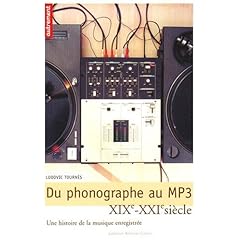
--The blurb--
"At a time when the history of music has been engaged in historic change since the turn of the century, this work sheds invaluable light on the industry, allowing reader to understand changes that are simultaneously technical, economic and cultural. Market globalisation, the formation of massive multimedia companies, rapports between major and independent labels, the evolution of recording techniques, the interbreeding of different types of music, and the changes in the way we listen are a multitude of issues that are successfully analysed together and given a more long-term perspective. It also presents the revolution provoked by the appearance of vinyl. And so in this work the history of different recording techniques is presented, as is the history of the record industry, the story of musicians who saw their world turned upside down by the arrival of sound recording, and the history of the general public, whose way of listening to music has developed all the way to the MP3 player. This teeming history brings together numerous artists who, despite their differing styles, have allowed the recording of music to become a historic method of distribution: Enrico Caruso, Charles Trenet, the Beatles, Glenn Gould, Michael Jackson, and many others.
(blurb from www.amazon.fr; translation mine)
--The review--
Continuing my non-fiction journey, this 2008 offering struck me as a unique entity: very few music technology books deal specifically with the art of recording and even fewer deal with it right through into the 21st century. This book's appearance is therefore encouraging, and what's even more encouraging is its conciseness, accessibility, and general dynamism. History books, of any description, are often written in a very dull manner, but Tournès's attempt is thankfully written with a vivid, lively, enthusiastic and engaging voice. This deep interest is highly contagious and is conveyed from the very first pages: it is always most helpful when an author is clearly enamoured with their subject.
The book is clearly and chronologically laid out, going from the very first methods and problems of recording right up to the obsolescence of tapes and records. It is crammed full of interesting facts, including how temperature could affect early recordings, and a beginners' glossary to help the uneducated decode various acronyms. There are also many monochrome pictures to help the authenticity factor along. The facts are well-researched and don't need much pimping to make them interesting, although, bizarrely, it was implied in the book's conclusion that the CD had already died out to make way for the MP3. A satiric prophecy, or something else? In any case, Tournès balances detail and finesse with accessibility and enthusiasm, leading me to hope that his books will soon be translated into English for the reading pleasure of Anglophones worldwide.
Other works by Ludovic Tournès
New Orleans sur Seine: histoire du jazz en France (1999)
L'informatique pour les historiens (2005)





No comments:
Post a Comment